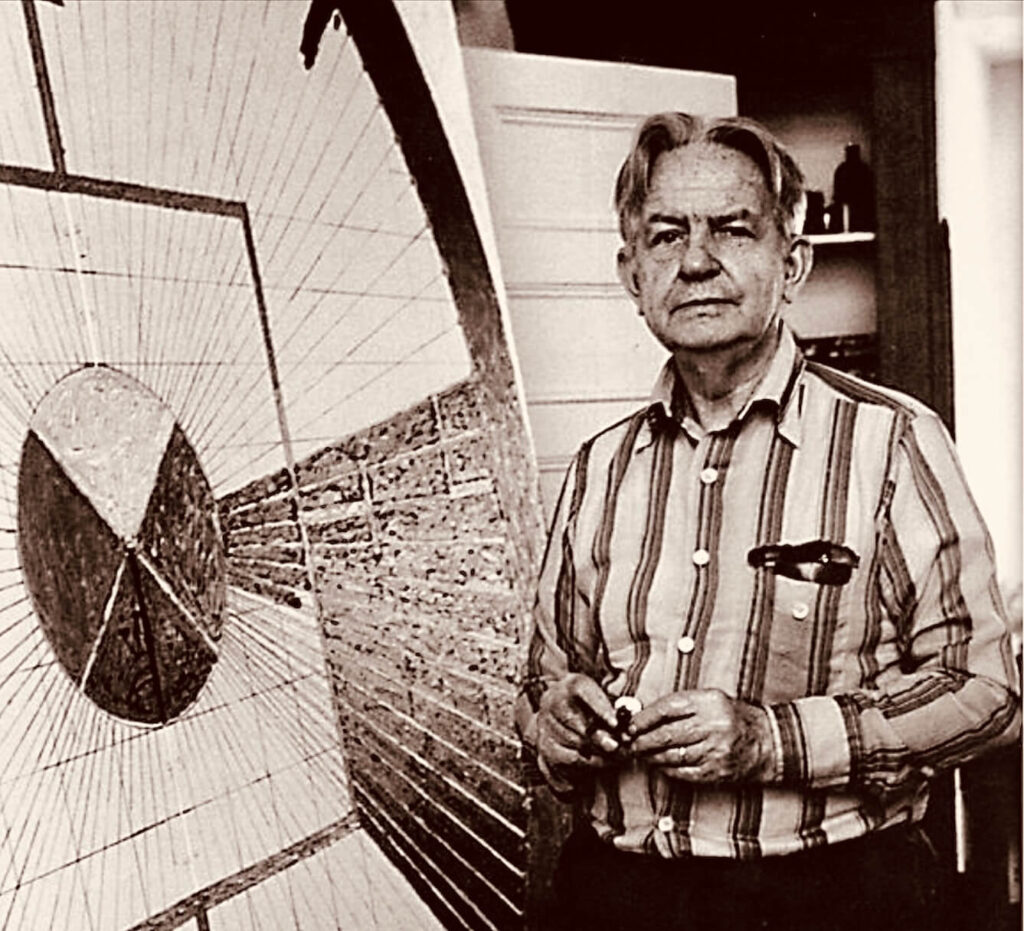Alfred Jensen
Alfred Jensen (1903-1981) was an enigmatic figure in the world of abstract art, known for his complex and richly textured paintings that explore themes of cosmology, mathematics, and color theory. Born in Guatemala and raised in Denmark, Jensen’s diverse cultural background and his deep intellectual curiosity significantly influenced his unique artistic vision. Throughout his career, Jensen created works that challenge the viewer’s perception and invite contemplation of the underlying order of the universe.

Early Life and Education
Alfred Julio Jensen was born on December 11, 1903, in Guatemala City, Guatemala. His father, a Danish engineer, and his mother, of German descent, provided a culturally rich environment that fostered his early interest in the arts and sciences. After the death of his father, Jensen’s mother remarried, and the family relocated to San Francisco, California. However, following the death of his mother, Jensen was sent to Denmark to live with his relatives.
In Denmark, Jensen received his formal education and developed a profound appreciation for the country’s artistic heritage. He attended the Tekniske Skole (Technical School) in Aarhus, where he studied painting and drawing. After graduating, Jensen continued his studies at the Academy of Fine Arts in Copenhagen, where he was influenced by the Scandinavian tradition of craftsmanship and the theoretical approaches to color and form.
Journey and Artistic Development
Jensen’s artistic journey took him across Europe and the United States, where he encountered various artistic movements and influential figures. In the 1920s, he traveled to Munich, Germany, where he studied at the prestigious Akademie der Bildenden Künste. During this period, Jensen became deeply interested in the works of the German Expressionists and the Bauhaus movement, which emphasized the integration of art, design, and architecture.
In the early 1930s, Jensen moved to Paris, the epicenter of the avant-garde art scene. Here, he befriended several key figures of modern art, including abstract painter Joaquín Torres-García and Piet Mondrian, whose theories on geometric abstraction and color would profoundly impact Jensen’s work. Jensen’s exposure to the Parisian art scene further fueled his interest in the intersection of art and science.
Abstract Expressionism and Color Theory
By the 1940s, Jensen had settled in New York City, where he became associated with the Abstract Expressionist movement. However, unlike many of his contemporaries who focused on gestural abstraction and the emotional content of their works, Jensen’s approach was more analytical and structured. He developed a unique visual language that incorporated elements of color theory, mathematics, and cosmology.
Jensen’s paintings are characterized by their meticulous construction and intricate patterns. He often used grids and numerical systems to create compositions that explore the relationships between colors and shapes. His use of vibrant, contrasting colors and precise geometric forms creates a sense of order and harmony, inviting viewers to contemplate the underlying principles that govern the universe.
One of the defining features of Jensen’s work is his exploration of color theory. He was particularly influenced by the theories of Goethe and the Bauhaus color theorist Johannes Itten. Jensen believed that color had a profound impact on human perception and emotion, and he sought to create works that harnessed this power. His paintings often feature complex color schemes and juxtapose complementary colors to create a sense of vibrancy and dynamism.
Important Artwork: “The Great Pyramid” (1979)
One of Alfred Jensen’s most significant works is “The Great Pyramid” (1979). This painting exemplifies his mature style and his deep engagement with cosmological and mathematical themes.
“The Great Pyramid” (1979)
“The Great Pyramid” is an acrylic on canvas that measures approximately 100 inches by 100 inches. The painting is a monumental exploration of geometric abstraction, featuring a complex arrangement of triangles and squares that create a sense of depth and perspective. The composition is dominated by a central pyramid, rendered in bold, contrasting colors that evoke a sense of energy and movement.
Jensen’s use of color in “The Great Pyramid” is particularly striking. The painting features a vibrant palette of reds, blues, yellows, and greens, arranged in precise geometric patterns. Each color is carefully chosen to create a sense of harmony and balance, reflecting Jensen’s deep understanding of color theory. The interplay of colors creates a dynamic visual experience, drawing the viewer’s eye across the surface of the painting and inviting contemplation of the underlying order.
The composition of “The Great Pyramid” is both complex and meticulously structured. Jensen’s use of grids and numerical systems is evident in the precise arrangement of shapes and colors. The painting’s central pyramid is flanked by smaller geometric forms, creating a sense of symmetry and balance. The overall effect is one of harmony and order, reflecting Jensen’s belief in the underlying principles that govern the universe.
“The Great Pyramid” is a testament to Jensen’s ability to combine artistic intuition with analytical rigor. The painting’s intricate patterns and vibrant colors create a sense of depth and movement, inviting viewers to engage with the work on both an intellectual and emotional level. Through his use of geometric abstraction and color theory, Jensen creates a visual language that explores the profound connections between art, science, and the cosmos.
Influence and Legacy
Alfred Jensen’s work has had a significant impact on the development of abstract art in the 20th century. His unique approach to color and form, combined with his deep engagement with mathematical and cosmological themes, set him apart from many of his contemporaries. Jensen’s paintings are celebrated for their intellectual rigor and their ability to convey complex ideas through abstract means.
Despite his significant contributions to abstract art, Jensen remained relatively underrecognized during his lifetime. However, his work has gained increasing recognition in recent years, with major exhibitions and retrospectives showcasing his unique vision. Jensen’s paintings are now included in the collections of prominent museums and galleries, including the Museum of Modern Art in New York, the Guggenheim Museum, and the Whitney Museum of American Art.
Jensen’s influence extends beyond the art world, with his work resonating with scientists, mathematicians, and philosophers who share his interest in the underlying principles of the universe. His exploration of the connections between art and science continues to inspire contemporary artists and thinkers, contributing to an ongoing dialogue about the nature of creativity and perception.
Personal Life and Philosophy
Alfred Jensen’s personal life was marked by a deep commitment to his art and his intellectual pursuits. He was known for his disciplined approach to painting, spending long hours in his studio meticulously constructing his compositions. Jensen’s intellectual curiosity extended beyond the realm of art, encompassing a wide range of subjects, including mathematics, cosmology, and philosophy.
Jensen’s artistic philosophy was rooted in a belief in the transformative power of art. He viewed painting as a means of exploring and understanding the fundamental principles that govern the universe. This approach is evident in the precision and rigor of his compositions, which reflect his belief in the underlying order and harmony of the cosmos.
Despite facing numerous challenges throughout his career, including periods of financial hardship and relative obscurity, Jensen remained dedicated to his artistic vision. His perseverance and commitment to his craft are evident in the body of work he created, which continues to inspire and captivate viewers.
Conclusion
Alfred Jensen’s artistic journey is a testament to his dedication, creativity, and profound understanding of color and form. Through his innovative approach to abstraction, he created a body of work that continues to inspire and challenge viewers. “The Great Pyramid,” one of his most important works, exemplifies his mastery of geometric abstraction and his ability to convey complex ideas through visual means.
In celebrating Alfred Jensen’s life and work, we recognize his significant contributions to the development of abstract art and his enduring legacy as both an artist and an intellectual. His paintings remain powerful and evocative, reminding us of the potential of art to transform our perceptions and engage with the fundamental questions of existence. Jensen’s exploration of the connections between art, science, and the cosmos continues to resonate, inviting us to contemplate the underlying order and harmony of the universe.
4o



